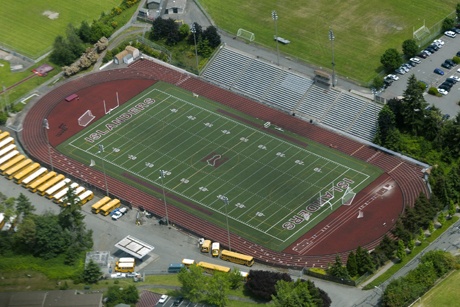The Mercer Island High School Stadium is getting an unexpected facelift.
After seven years of wear and tear, Islander Stadium’s artificial turf field is being pulled out and replaced entirely. The improvement comes as a surprise, since the field’s eight-year warranty does not expire until Oct. 1, 2010.
The turf, which accommodates MIHS and city-organized football, soccer and lacrosse teams, as well as the MIHS band, track and field team and Island residents, has been showing signs of deterioration for months now. According to Mercer Island High School Athletics Director Craig Olson, pieces of the turf field were falling apart and the field recently failed a periodic safety test.
Last spring, Olson spoke with the field’s manufacturer, FieldTurf Tarkett, about the problem.
“The field didn’t meet standards for resiliency. It was determined that strands of turf had lost height. Bits and pieces were torn away,” Olson said.
Since there was more than a year left on the 2002 warranty, the turf company offered to remediate the situation by plugging in 16,000 pounds of rubber pellets, theoretically increasing the field’s cushion factor. The company covered all costs. Unfortunately, the effort was unsuccessful.
“We thought the 16,000 pounds of rubber pellets — pushing the pellets into the turf to increase resiliency — would solve the problem. It didn’t,” said MISD Business Services and Human Resources Executive Director Dean Mack, who was working with FieldTurf Tarkett to mediate the issue.
With a full schedule of athletic events scheduled for stadium use in the fall, Mack forwarded his recommendations in late July to MISD Superintendent Gary Plano for replacing the field surface.
“It was determined that we’d need a new field,” Plano said.
And so began a last-minute scramble to arrange for FieldTurf Tarkett to replace the stadium turf before the 2009 high school sports season begins in September.
A city and school district ad-hoc task force, established in April to discuss the field’s deterioration, decided last month that the replacement project must begin on Aug. 17, in order to be complete by Sept. 1, the first week of MIHS sports. FieldTurf Tarkett confirmed that a new field could be installed and ready for play by Sept. 7, but no earlier.
As for cost, the company offered a 20 percent price reduction, since 14 months remained on the warranty.
District and FieldTurf Tarkett representatives debated and negotiated until both sides agreed on the overall replacement cost of $455,504, which includes the 20 percent discount.
The district will cover the amount with money from its Capital Projects fund.
Although a surprise, Mack said the district can afford the last-minute project. After all, it is a matter of safety.
“If someone were injured while playing, the potential for lawsuits is too great,” Mack said. “This is not great timing at all, but under the circumstances, this [summer] is the only time we could get it in.”
Mack added that one of the most important factors, after safety, is the quality of the final product. FieldTurf Tarkett has assured the district that the new turf it plans to install is the best on the market.
“Husky Stadium and Qwest Field just had their stadiums redone, and it’s the same product we’re using,” Mack said.
Mack added that the district was satisfied with the company’s 20 percent rebate offer.
As for whether the new field lives up to its eight-year warranty, only time will tell.
The original MIHS stadium playing ground — a grass field, often turned into a muddy swamp by Northwest rains — was transformed into synthetic turf in 2002. The $1.1 million project was covered by Capital Levy funds. Island voters supported the initiative at the ballots earlier that spring. The city of Mercer Island also pitched in, pledging $500,000 in exchange for public use of the field.
Today, the district wonders if the city will help foot its $455,000 bill for turf replacement.
According to City Mayor Jim Pearman, this will be decided by the ad-hoc task force, which includes City Council and School Board members.
The committee meets on Aug. 24 to discuss joint financial options, as well as city/school district usage of the field and a potentially new interlocal agreement.
A 2007 report shows that MIHS sports filled up 62 percent of the actual time that Islander Stadium was used, totaling 1,161 hours. In comparison, community club sports made up 20 percent of the field’s availability, for a total of 701 hours of use in 2007.
The city argued that pursuant to its interlocal Islander Stadium usage agreement, signed in 2004, the district should allow for more public use of the field. A 2004 study predicted that non-district sports clubs would use nearly five times that amount at 3,262 hours.
“The 3,000 hours don’t exist,” said School Board member John DeVleming during an Aug. 13 board meeting. “The estimate of revenue the city is expecting is not based on real numbers.”
In the past year, however, the city and the district have come to more agreeable terms, opening up extra hours for public use of Islander Stadium.
But the new contract with FieldTurf Tarkett requires the city and school district to re-examine their commitments — both financial and organizational — to Islander Stadium.
Pearman said the topic has become a new — albeit last-minute — summer priority, and will be discussed among ad-hoc task force members on Aug. 24. Until this time, the mayor said he could not comment on the city’s expectations.
“All I can say is that we are interested in working well with the school district, and we want to keep the stadium usable for interests greater than MIHS sports,” Pearman said.
For history on the field, search ‘Islander Stadium’ at www.mi-reporter.com.



